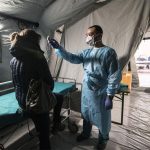 Used for the first time in 1348. The first law was passed in Marseilles, France, in 1383. Venice imposed a 40-day in 1403 is essentially an attempt at controlling the spread of disease by restricting the freedom of one who has a contagious disease and those who are well but suspected of transmitting it to others, isolation.
Used for the first time in 1348. The first law was passed in Marseilles, France, in 1383. Venice imposed a 40-day in 1403 is essentially an attempt at controlling the spread of disease by restricting the freedom of one who has a contagious disease and those who are well but suspected of transmitting it to others, isolation.
The limitation of freedom of movement of susceptible persons or animals that have been exposed to a communicable disease, in order to prevent spread of the disease; the place of detention of such persons or animals; or the act of detaining; vessels or travelers suspected of having communicable diseases at ports or places for inspection or disinfection.
The situation in which a person, animal or ship just arrived in a country is kept isolated in case it carries a serious disease, to allow the disease time to develop and be detected.
The period of such isolation to prevent the spread of disease.
Isolation of people having communicable diseases or exposed to communicable diseases during the period of contagion in an effort to prevent the spread of the disease.
The isolation of a person or persons for the purpose of preventing the spread of a known or suspected infection with a contagious disease. Quarantine is a medical strategy for limiting a large or small community’s exposure to infectious pathogens. It may be imposed on people who have been exposed to serious contagious diseases, as well as on those who have acquired a contagious infection or who are believed to have been infected.
The period for which a person (or animal) is kept in isolation to prevent the spread of a contagious disease. The original quarantine was a period of 40 days, but different diseases now have different quarantine periods.
The principle of preventing the spread of infectious disease by which people, baggage, merchandise, and so forth likely to be infected or coming from an infected place are isolated at frontiers or ports until their harmlessness has been proven to the satisfaction of the authorities.
The period during which free entry to a country by humans, animals, plants, or agricultural products is prohibited, in order to limit the spread of potentially infectious diseases.
The entirety of actions linked to averting the transmission of undesirable organisms amidst and amongst territories.
The act of segregating an individual or animal that has been recently exposed to a severe infectious ailment, aiming to hinder the disease’s dissemination by asymptomatic carriers.
Quarantine measures are infrequently employed nowadays, primarily due to the decreased occurrence of severe infectious illnesses and the widespread availability of vaccinations against a multitude of them. The primary existing quarantine protocols are enforced for animals being brought into nations that are rabies-free.
The isolation of individuals or animals exposed to a contagious disease for a duration matching the disease’s longest typical incubation period; the location where they are kept; the practice of holding ships, travelers, or aircraft coming from potentially infected areas; and authorized sites for inspection or disinfection.
